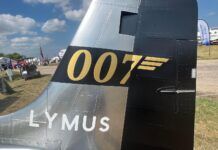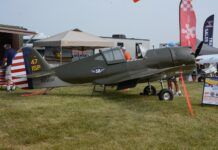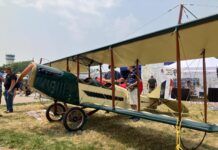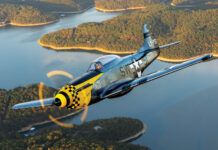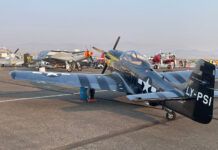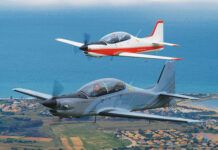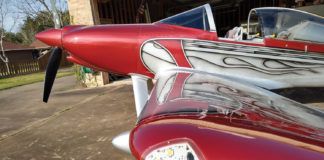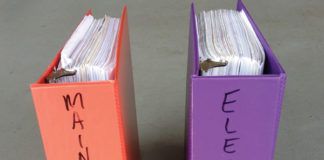It’s a known fact, at least to the stalwart stud muffins of The Dawn Patrol, that chainsaws that start on the first pull and run fine in the garage won’t even try to start in the woods. We’ve proved that time and time again over the years.
When we gathered at our houses to clean up debris after one of Mother Nature’s tree-trimming sessions (aka a “big, black, surly” Missouri summer thunderstorm), those aggravating little suckers would not run.
Swearing a blue streak while furiously cranking on a chainsaw on a steamy afternoon in the middle of the deep woods, dripping with sweat, is one of those yeasty experiences that every red-blooded American male has probably had, or needs to have, at least once. It’s a real character builder.
On the other hand, Tom Glaeser’s Missouri Madness Chainsaw Starting System that we all use on our beloved Graham Lee Nieuport 11 replicas and Dick Lemons’ incredible Airdrome Aeroplanes 75%-scale replica Fokker DR-1 triplane have worked like troopers since they were first installed in 1990. They are so powerful that we could crank up the mighty McCullough “Eager Beaver” 32cc chainsaw engine, stomp in the plunger that engaged the Bendix, open the throttle on the chainsaw, and that little screamer would turn the prop so fast that we could get oil pressure indicated on the gauge before turning on the ignition.
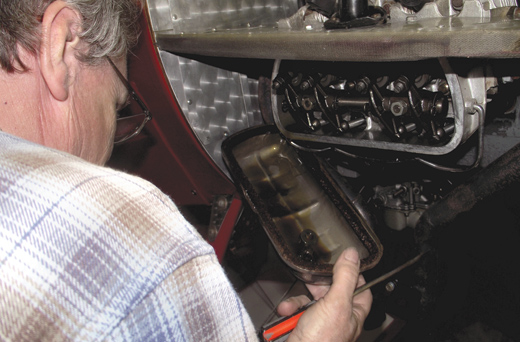
Tom Glaeser looks with stunned amazement at the loose nuts found in the rocker cover of the VW engine on Dick Lemons’ Airdrome Aeroplanes Fokker DR-1 replica. All the nuts were loose, and no one took responsibility for not tightening them.
Alas, McCullough went toes-up in 1999, and the handwriting was on the wall. Parts were eventually going to be hard to get.
So, in true historical form for The Dawn Patrol, we ignored the looming problem and soldiered on. We kept on using Glaeser’s invention, hoping that the little powerhouses would keep running forever.
They almost did. But in the spring of 2011, they finally started to say goodbye. First came the problem of getting them to start. When we didn’t get a cloud of smoke and the scream of an outraged two-stroke by about the fourth or fifth pull, we should have given up. As it was, you’d see the pilot bouncing around in the cockpit like a gerbil on a skillet while he frantically pulled out the starter rope, accompanied by a purple cloud of invective directed at the poor worn-out little engine. It got progressively worse and worse.
Lemons was so sure his chainsaw was going to be the first to go that he’d already been researching a replacement starter for the engine on his Fokker DR-1. With the prop-speed-reduction unit (PSRU) on his plane, it can’t be hand-propped like the direct-drive VWs on our Nieuports. He found an electric starter motor from a Briggs & Stratton garden tractor that was lighter than our chainsaw engines. Because of the very large 30:1 reduction on the present starters, it also does the job. The best part is that it could bolt on in place of the chainsaw engine and use the same belt/chain/sprocket Bendix arrangement already in place.
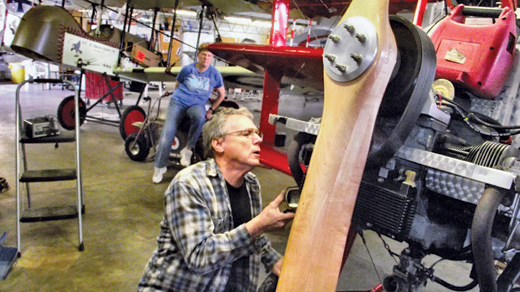
Glaeser examines the fit of the new pushrod tubes on the engine after all the head nuts had been correctly tightened. The author’s wife, Sharon, watches from a safe distance. Engines are not her specialty.
As luck would have it, the chainsaw starter on my Nieuport was the first to throw craps. It was a hot day. I mounted my beloved 25-year-old “Canvas Falcon” and prepared for another harrowing mission over the German trenches in the fields surrounding Liberty Landing International Airport.
I pulled out the choke knob for the chainsaw, grabbed the starter rope and gave a mighty pull. It started…then stopped. Same thing again and again, for a long time. The rest of the mob came over to offer suggestions and take turns yanking on the starter rope from outside the cockpit, to no avail.
We pulled the cowling, and the head-scratching began. We removed the super-simple carburetor and examined it. All was seemingly well. Everything was put back in place, and the trials started again. Same results and no hope in sight.
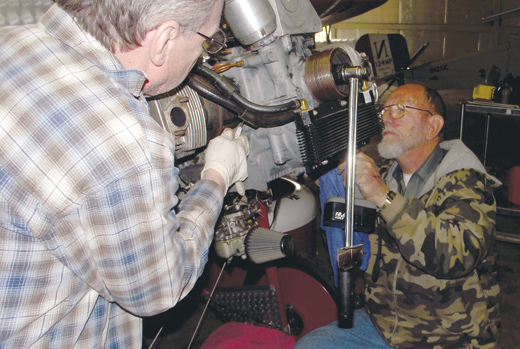
Glaeser and Lemons work on the final installation of the new pushrod tubes.
That did it for me. My patience burned out with a flash. Grabbing a handful of tools, I spent a few hours totally stripping the chainsaw starter, tank and all other controls out of the plane. Everything was grouped together and weighed for the new weight-and-balance figures after the electric starter was installed. I got on eBay that night and found a brand new Briggs & Stratton electric starter for a 14-horsepower garden tractor for a good price.
The new motor arrived. It was smaller than I expected and lighter than the complete chainsaw starter package. I’d be able to use the same garden-tractor battery that I was currently using for our smoke systems, so the weight change would be negligible.
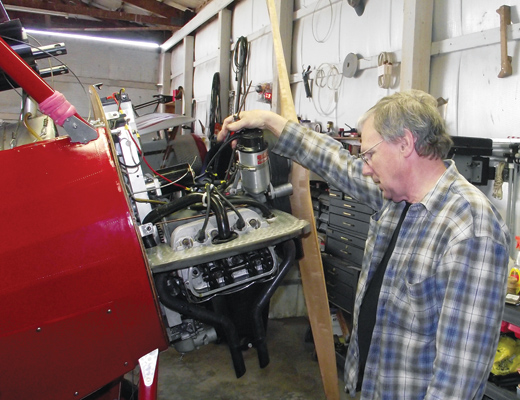
With everything finally fit into place to his satisfaction, Glaeser gets ready to torque down all the head nuts and button it up.
Food for Thought
The only problem was the new starter motor turned in the wrong direction. After an hour of head-scratching, Dawn Patrol members Glaeser and Mark Pierce solved the problem. The motor brushes were moved 90°, and that reversed the direction of rotation. A new mounting plate was fabricated, and the whole assembly was bolted in place exactly where the chainsaw motor had been.
The first smoke test went just fine. It didn’t spin the engine like the chainsaw did, but the engine started each time with no problem.
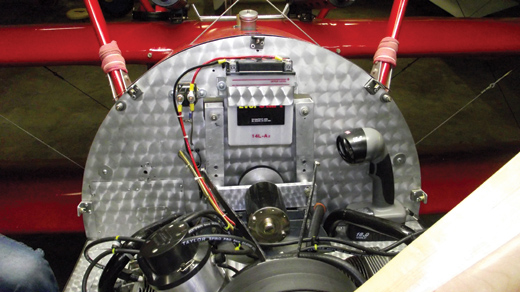
Lemons’ super-neat installation of the new Briggs & Stratton electric starter on his Fokker DR-1 replica.
I was satisfied, and there was only one thing left to do. There is no generator or alternator on my Nieuport, so I knew I was going to have to find a way to jump-start the VW if or when the battery went down. To jump it as it was, I’d have to pull the cowling to connect jumper cables to the forward-wall-mounted battery. I ran a short length of heavy-duty extension cord from the battery to a plug in the cockpit. Then I fabricated the rest of the extension cord with a plug that matched the polarity of the plug on the cockpit cord. I can now jump-start the VW from the cockpit, unplug the jumper cord, throw the cord over the side and taxi away. It works fine.
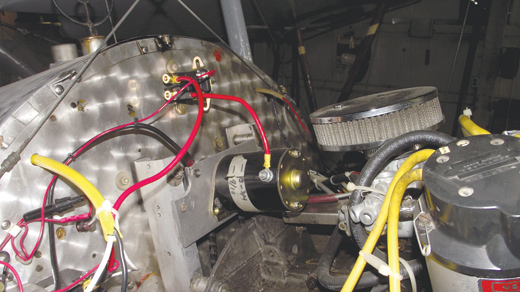
The author’s electric starter in the same place occupied by the chainsaw starter. The yellow cord is the jumper cord that can be hooked up with an external battery from the cockpit. After the engine starts, the cord will be unplugged, and the plane and pilot just taxi off.
Lemons got so excited seeing how the new starter was working on my Nieuport that he got ready to do the same thing on his Fokker. Now, his chainsaw was still working OK. I asked if he was sure he wanted to do this and he said, “You know me. Once my mind’s made up, I’m iffy.” Still, he was determined to do it. Going to school on my starter installation, he naturally made his a much nicer, neater and more compact package than mine. It was impressive, and it turned the engine over nicely.
The only fly in the ointment was that the Fokker’s engine would not start. We tried and tried to make it give even a discrete ladylike snort. Nothing. This was weird. The engine had just been put back together after we’d all worked on replacing some leaking pushrod tubes. The heads had been pulled, new pushrod tubes installed and everything put back together in record time. We could not understand why it didn’t want to run.
Finally, we checked the compression on the cylinders. Three were very low, and one showed no compression at all.
Glaeser pulled the rocker cover of the side of the engine with the cylinder with no compression. Imagine our surprise when we found two loose head nuts rattling around in the bottom of the rocker cover. Further examination showed all the other head nuts were just finger-tight.
That’s the problem with a headless committee working on an engine. There’s no one person to blame. Accusatory fingers were pointed everywhere and at everyone, and insults were hurled.
No one would admit to remembering to tighten the cylinder-head nuts and then not doing it. Of course, no one could remember who was supposed to tighten them. The recriminations were bitter, and a few were pretty darned insulting.
Even my wife, Sharon, was mentioned as the reason for the disastrophe. She hadn’t even picked up a tool, yet she got blamed for distracting us with calls to eat lunch while we were in the middle of the reassembly. (Not coming to eat when she orders you to is an act no sane male would contemplate.)
The engine issues were resolved in a couple of hours. After an extensive final check, we tried the new starter again. The mighty VW fired off after about two blades had gone by and ran like a charm. So now we had two engines modified from chainsaw starters to garden-tractor starters.
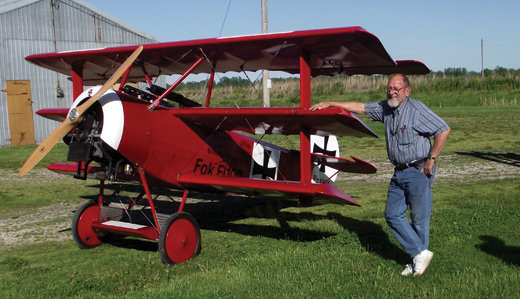
With starting problems solved, Lemons stands proudly beside his pride and joy. He did an incredible job on this beautiful plane, and it flies great! Check out the videos on YouTube.com. Type in “dstarks1943” to get a list of the videos and enjoy the air-to-air work.
The first big test of the new starters was the Salute to Veterans Memorial Day Air Show at Columbia, Missouri. Both planes flew both days, and the starters worked flawlessly. The smoke system batteries started the engines and ran the smoke systems with no problem. Two weeks after Columbia, the planes flew a number of times at the Gathering of Eagles at Gardner, Kansas. Again, the batteries were not charged overnight, and they went through numerous starts the next day with no sign of weakening.
The chainsaw starters had worked great for 20 years, but time finally caught up with them. The new ones take just a push of a button to start the mighty VWs. As far as I’m concerned, it is a change for the better.



